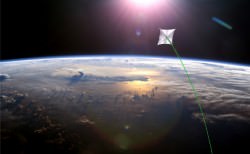Sooner or later we’re going to want to move the Earth further away from the Sun. It turns out, there are a few techniques that might actually make this possible. Not easy, but possible.
You live here. I live here. Everybody lives here. For now.
In 500 million years the gradual heating of the Sun will burn away all life on Earth. Then we might have to move. Even if we get past the 500 million year deadline, the Sun will die as a red giant in about 5 billion years.
Let’s review our options? We could die… orrrr we could move the Earth. Just like any other mad science scheme, there’s a hundred ways to skin this cat. We could launch powerful rockets off the Earth, which would push the Earth a little bit in the opposite direction.
We could build a giant teleporter and disassemble the Earth atom by atom into a new location. We could repeatedly smash things into the Earth. Eventually knocking it off orbit, possibly also changing its axis and or rotation.
We could paint half the Earth silver, stop it rotating and let the Sun push it away. We could dig a giant hole down to the core and repeatedly detonate warheads inside the Earth forcing molten material to fly off into space, propelling us forwards like a deflating balloon.
Sure, maybe that does all sound a little crazy. We could build a gravity tug, and slowly pull the Earth away from the Sun. What’s a gravity tug? I’m so glad you asked.
You could build a solar sail with a huge mass connected to it. This gigantic weight would want to fall towards the Earth, and the Earth slowly drifts towards the weight. The solar sail is being pushed away by the Sun dragging both the weight and as a result the Earth along with it. This would take a very, very, very long time.

Here’s the best idea scientists have come up with so far. Gravity assists: Attach rockets to an asteroid, comet or Kuiper belt object and have it fall on a trajectory that takes it close to the Earth. Earth and this space rock would exchange a little momentum.
The rock slows down a bit and goes into a new orbit, and the Earth speeds up a little. That additional momentum pushes our orbit up a tiny little bit, and now we’re further away from the Sun. You’d need to do this tens of thousands or even a million times.
You might think, “Hey, that’s crazy. Where would you get all this stuff to hurl past the Earth?”. Don’t worry, the Oort cloud alone has billions of objects with a total of 30 times the mass of the Earth.
To prepare for Roastpocalypse, If we started now, we should cause a close pass with a large object every few thousand years. We bring them within 10,000 km of the surface of the Earth, which would have the likely side effect of causing severe tides and storms.

Oh, and get the math wrong and you’ll smash an asteroid into the Earth. Just so you know, these would be way bigger than the object that killed the dinosaurs. One hit from a 100km diameter object would sterilize the biosphere.
If we pushed the Earth out to about 1.5 times its current orbit, which might get a little too cozy with Mars for comfort, we’d give the Earth another 5 billion years of habitability,
Then the Sun turns into a red giant, and then dies as a white dwarf. And nothing can help us then… except perhaps some kind of planet sized star gate.
What do you think? What’s the best suggestion you’ve got to move the Earth out to a safe distance? Tell us in the comments below.

